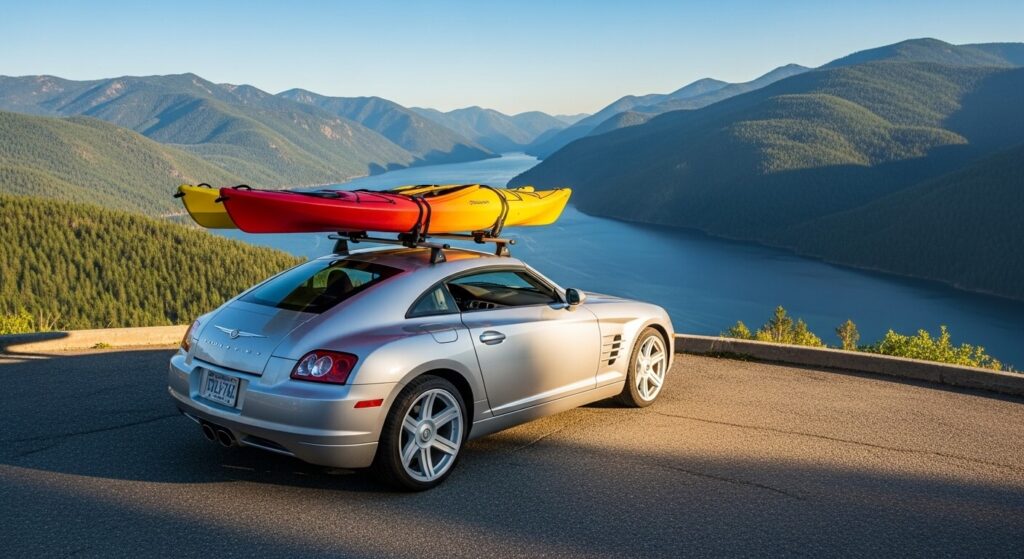The Chrysler Crossfire isn’t exactly the first car people think of when hauling a kayak, but that sleek coupe can surprise you if you set it up right. The trick is finding a kayak rack that balances security with the Crossfire’s sporty build, without looking like you strapped a jungle gym on the roof. Most options wobble or eat into roof space, but after digging through reviews and actual user setups, the one rack that really feels like it belongs is the GZDEMYYXGS Folding Kayak Roof Rack. It’s sturdy, folds down when you’re not using it, and fits the Crossfire’s tighter roofline without making loading a nightmare.
Best 5 Kayak Racks for Chrysler Crossfire
01. GZDEMYYXGS Folding Kayak Roof Rack
The GZDEMYYXGS Folding Kayak Roof Rack is built for drivers who need a sturdy carrier for kayaks, paddleboards, or canoes without fuss. Its foldable design makes it easier to store when not hauling, and the heavy-duty steel construction with padded supports helps protect your kayak while staying secure on highways. This roof rack works with most crossbars, making it a practical option for SUVs, trucks, and sedans looking for reliable kayak transportation.
Pros:
- ✅ Strong steel build for long-lasting use
- ✅ Foldable design for storage convenience
- ✅ Works with kayaks, SUP boards, and canoes
- ✅ Compatible with most factory and aftermarket crossbars
Cons:
- ❌ Installation may take extra time for first use
- ❌ Not the lightest option compared to aluminum racks
- ❌ Straps could feel short for very wide kayaks
02. JDM Kayak Roof Rack
The JDM Kayak Roof Rack is built for paddlers who want reliable transport for their gear without spending a fortune. Designed to fit most crossbars, this J-style rack makes it easier to secure kayaks, canoes, paddleboards, or even small boats. The steel frame with adjustable padding provides solid stability on highways, while also protecting hull surfaces from scratches. Whether you’re planning weekend trips to lakes, rivers, or coastlines, this rack can handle the load with dependable strength and simple installation.
Pros:
- ✅ Heavy-duty steel construction for durability
- ✅ Works with kayaks, canoes, and paddleboards
- ✅ Foam padding reduces scratches and dents
- ✅ Easy to install on most crossbars
Cons:
- ❌ Straps may need upgrading for long-distance hauls
- ❌ Not the best option for oversized fishing kayaks
By using this JDM kayak carrier, you also expand transport options for outdoor gear. Many SUV and truck owners prefer J-style racks for their compact folding design, as they leave extra roof space for other cargo. With proper tie-downs, the rack helps keep your kayak secure even on bumpy rural roads or windy highways. If you’re looking for a budget-friendly kayak transport solution, this rack gets the job done while covering the basics needed for safe and steady hauling.
03. Malone J-Pro 2 J-Style Universal Car Rack
The Malone J-Pro 2 J-Style Universal Car Rack is built for paddlers who need a sturdy and secure way to carry kayaks on different vehicles. With its steel frame, corrosion-resistant coating, and universal fit design, this roof rack works well with most crossbars—round, square, or factory-installed. It comes padded for extra protection, so your kayak won’t get scraped while loading and unloading. Outdoor enthusiasts searching for kayak roof racks, J-style carriers, or car kayak racks will find this a reliable option for both short trips and long drives to lakes, rivers, or coastal spots.
Pros:
- ✅ Universal fit for most crossbars (round, square, factory, and aero).
- ✅ Strong steel frame with corrosion-resistant coating.
- ✅ Foam padding keeps kayaks safe from scratches and dents.
- ✅ Includes load straps and bow/stern tie-downs for added stability.
Cons:
- ❌ Bulkier than folding J-style racks, so storage space may be an issue.
- ❌ Can limit roof space if you plan to carry multiple boats or gear.
04. SLSWHLX Direct Aftermarket Universal Kayak Rack
The SLSWHLX Direct Aftermarket Universal Kayak Rack is built for car owners who want a simple, sturdy, and affordable way to carry kayaks without needing factory-installed crossbars. Its universal design makes it compatible with a wide range of vehicles, making it a practical pick for casual paddlers and weekend adventurers. Whether you’re carrying a single recreational kayak, canoe, or even paddleboard, this roof rack helps secure your gear during transport.
Pros:
- ✅ Universal fit for different vehicles
- ✅ Easy to install and remove when not needed
- ✅ Works for kayaks, canoes, and paddleboards
- ✅ Budget-friendly compared to premium roof racks
Cons:
- ❌ Not as durable as heavy-duty steel racks
- ❌ Limited weight capacity for larger tandem kayaks
- ❌ Padding could wear faster with frequent use
- ❌ May require extra tie-downs for highway trips
05. Malone Downloader 2-Pack Roof Rack
The Malone Downloader 2-Pack Roof Rack is a sturdy J-style kayak carrier that fits most factory crossbars, round bars, and square roof racks. It’s built for paddlers who need a secure and reliable way to load two kayaks for road trips, weekend paddling, or fishing outings. The folding frame makes storage easier when not in use, and the package comes with the Malone SpeedLine system for quicker tie-down, which is a bonus compared to many kayak racks on the market. Ideal for sedans, SUVs, and trucks, it’s designed with padding that helps protect your kayak’s hull during transport.
Pros:
- ✅ Compatible with a wide range of crossbars (factory, round, square, and aero)
- ✅ Includes Malone SpeedLine tie-down system for faster loading
- ✅ Fold-down design for low clearance and easy storage
- ✅ Durable corrosion-resistant frame with padding for kayak protection
Cons:
- ❌ Can be bulky if you’re only carrying one kayak
- ❌ Initial assembly may feel time-consuming for first-time users
- ❌ Adds height to your vehicle, which may limit garage clearance
How to Choose The Best Kayak Racks for Chrysler Crossfire
The Chrysler Crossfire is not your typical “throw a kayak on the roof” kind of vehicle. Sleek coupe lines, sloping roof, barely enough headroom for tall folks, and here you are thinking about strapping a 12-foot boat on top of it. Crazy? Maybe. Impossible? Not really. But picking the right kayak rack for this car isn’t just about brand names. It’s about engineering, clearance, weight distribution, and, frankly, a willingness to look slightly ridiculous pulling up to the lake in a sports coupe with a kayak perched overhead.
The roof situation nobody talks about
The Crossfire doesn’t come with factory roof rails. That’s step one. You can’t just buy any generic kayak rack and call it good. You’ll need a base roof rack system first—crossbars that clamp to the roof edges or door frames. Most aftermarket brands design “fit kits” for cars like this. Without crossbars, no kayak rack works, period. Some owners go with Thule or Yakima base systems, often around $400–$600 installed. Pricey, but the roofline is unique, and generic fit kits won’t hold steady at highway speeds.
A side note: the Crossfire’s roof curves downward more aggressively than many sedans. That means bars sit closer to the glass, making clearance a headache. Go too low-profile and your kayak might touch the paint or antenna. So always check bar height before adding a kayak cradle.
Types of kayak racks and their quirks
There are a few categories of racks to consider, each with pros and cons, especially for a coupe.
J-style racks: These cradle the kayak on its side. They save roof space, but they also raise the profile, so expect wind noise. A single J-rack costs $150–$250, depending on padding and brand. On a Crossfire, they look a bit comical, but they work.
Saddles: These are low-profile cradles that hold the kayak flat, belly-down. Better aerodynamics, easier loading, but they take up more roof space. Average cost is $120–$200 for a full set.
Stackers: Designed to hold multiple kayaks on their edge, like stacking books. Overkill for a Crossfire, since you’re not hauling a family’s worth of kayaks on this car.
Foam blocks/temporary pads: The budget route. You set foam blocks directly on the roof, strap the kayak, and pray nothing shifts. Cheap, yes, but risky for paint and stability. Still, for occasional use, a $40 foam block kit isn’t the worst idea.
Weight limits and why you can’t ignore them
The Chrysler Crossfire roof isn’t meant to hold huge loads. According to specs from similar coupe builds, dynamic roof capacity is around 100–120 pounds. That includes crossbars, racks, and kayak combined. A standard single kayak weighs 35 to 65 pounds. Add in the rack system (20–40 pounds) and you’re already pushing the limits. Two kayaks? Forget it. Stick with one boat and make peace with that.
Wind drag is another hidden issue. A kayak on a coupe roof acts like a giant sail. At 65 mph, drag forces can exceed 100 pounds of lift on the racks, depending on angle and crosswinds. So even if the math says weight is fine, aerodynamics might still punish you.
Installation and the fiddly parts
Most people underestimate installation time. A base rack on a Crossfire can take 1–2 hours to fit correctly. Then you mount the kayak cradle. Strapping down the kayak safely takes another 10–15 minutes every trip. Always use bow and stern tie-downs. Skipping them is tempting, but one strong gust on the interstate can yank a poorly strapped kayak loose, turning it into a hazard for everyone behind you.
Pro tip: nylon straps with cam buckles beat ratchet straps. Ratchets can over-tighten and dent your roof line. Cam buckles let you snug down without crushing fiberglass.
Costs stacked up against reality
Here’s the uncomfortable part: you might spend $600–$800 total by the time you buy crossbars, a decent kayak rack, and straps. That’s a chunk of change. For some, it’s more than the kayak itself. But compare that to roof damage, or worse, a kayak flying off at highway speed. Suddenly the cost feels less ridiculous.
Some folks avoid racks entirely and go with trailer setups, especially if they already tow small loads. But the Crossfire isn’t rated for towing in the U.S., so unless you modify, that’s not an option. Roof rack it is.
The human side of it
There’s a kind of satisfaction when you pull up at the water with a kayak on a car people never expected to see hauling one. You’ll get stares, maybe even a laugh or two. But it works if you do it right. The biggest challenge isn’t the kayak itself—it’s the prep, the racks, the tie-downs, the patience. People who skip inspections, or strap fast and loose, end up with cracked windshields, ripped paint, or kayaks lying across the highway.
Final thought, messy but honest
Choosing the best kayak rack for a Chrysler Crossfire isn’t about style. It’s about compromise. The car wasn’t built for roof hauling, yet with the right system—crossbars, J-cradles or saddles, solid straps—it can carry a kayak safely. Keep it to one boat, watch the weight, double-check tie-downs, and accept the quirks. Because at the end of the day, the best rack is the one that keeps your kayak on the roof and not bouncing down the freeway.






